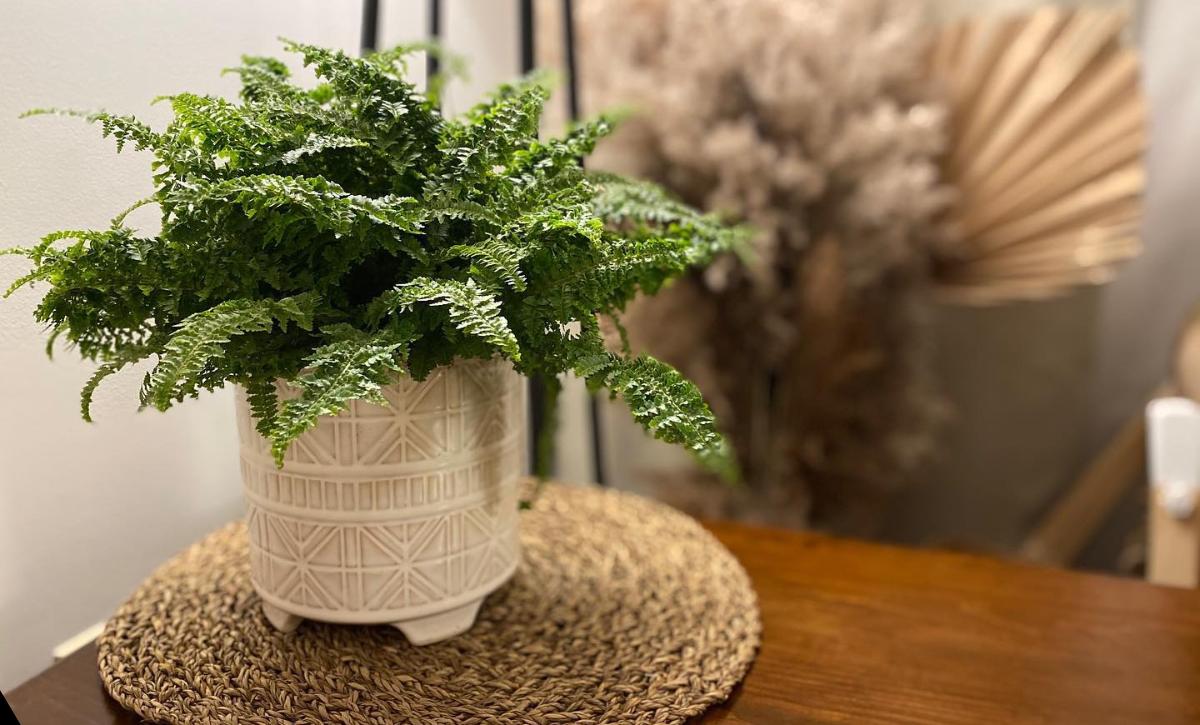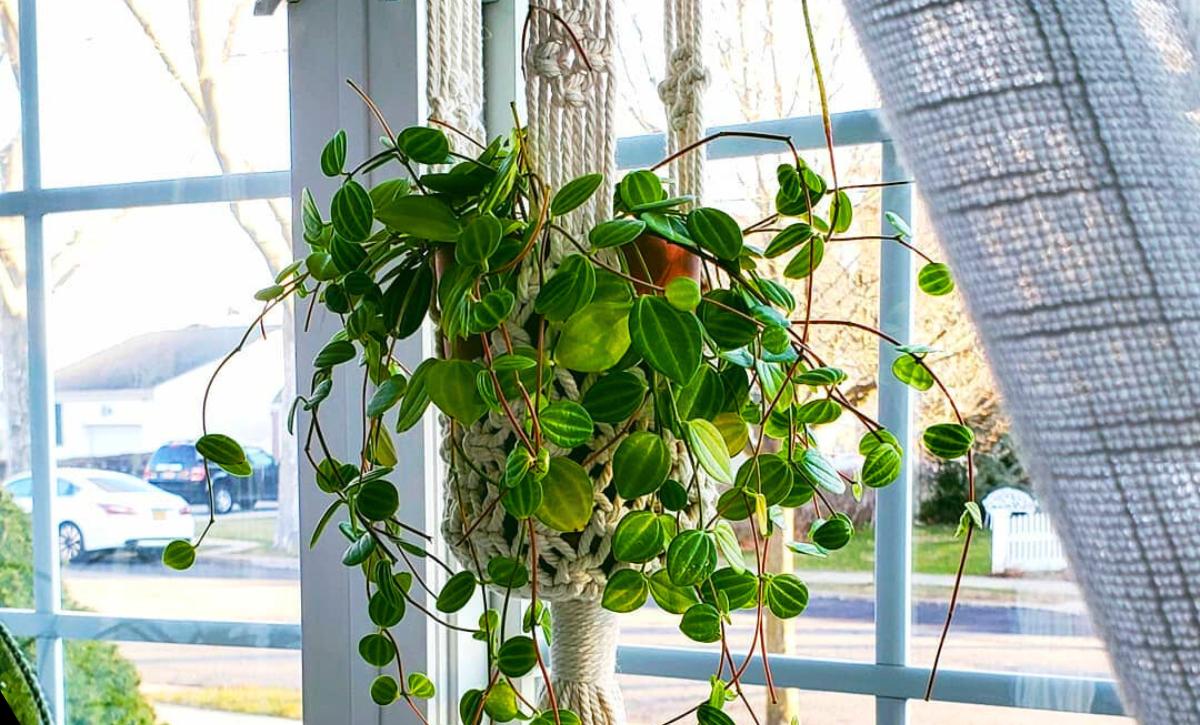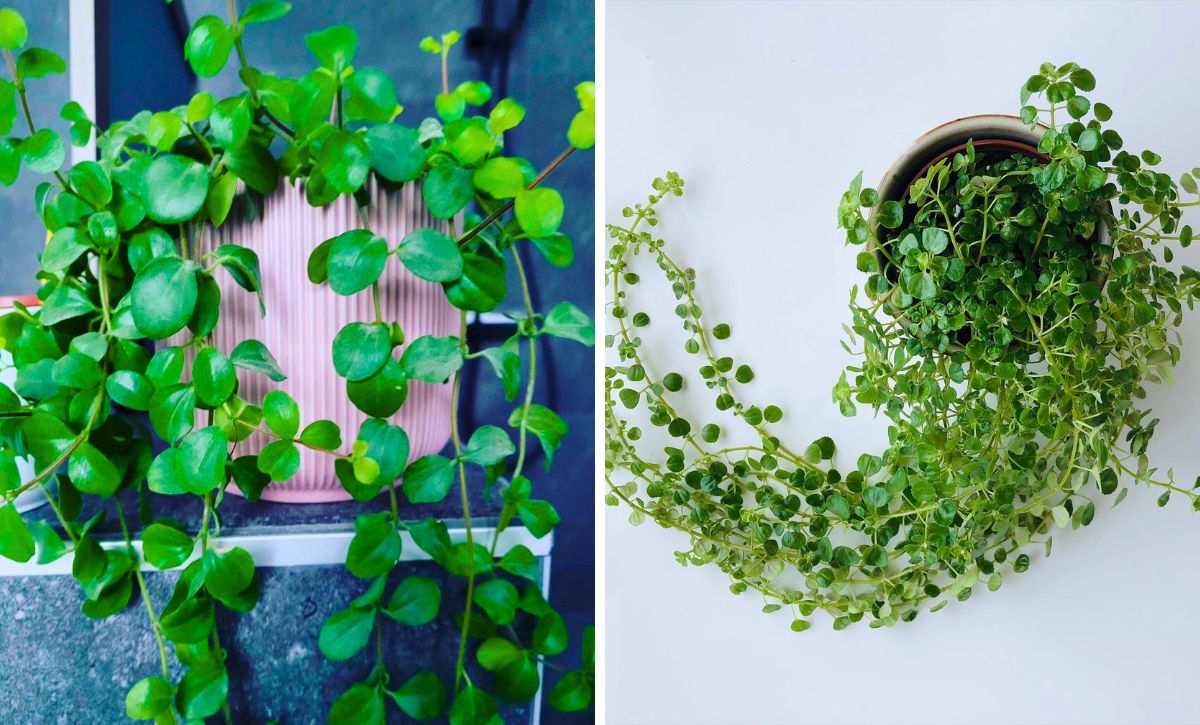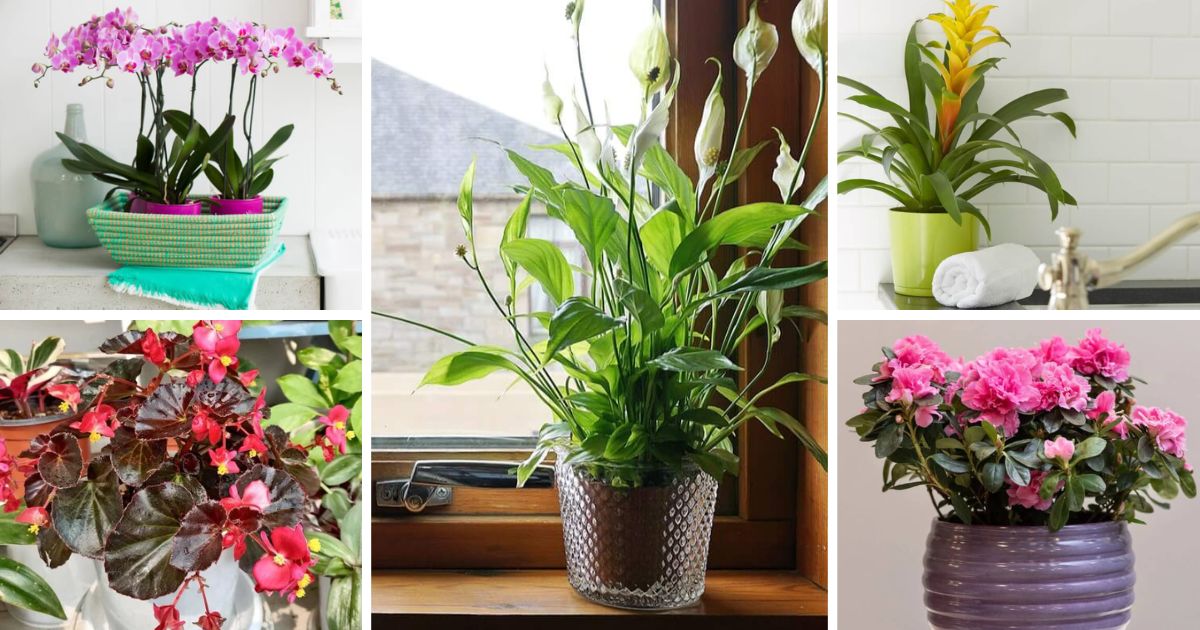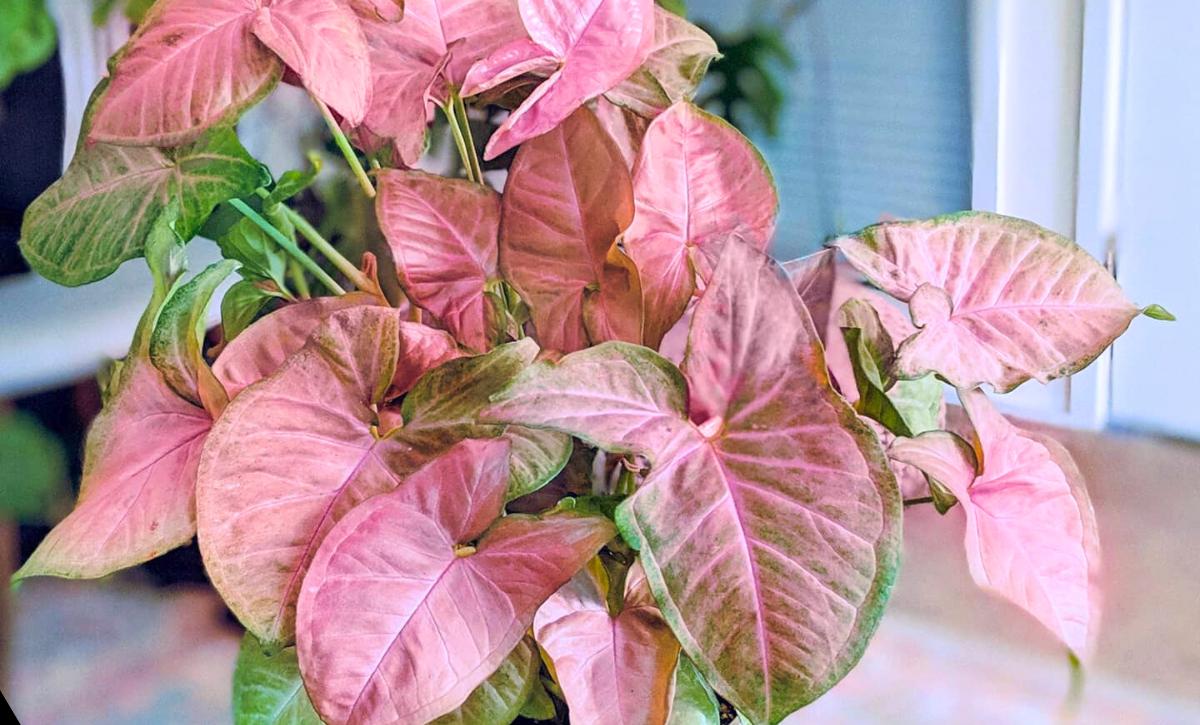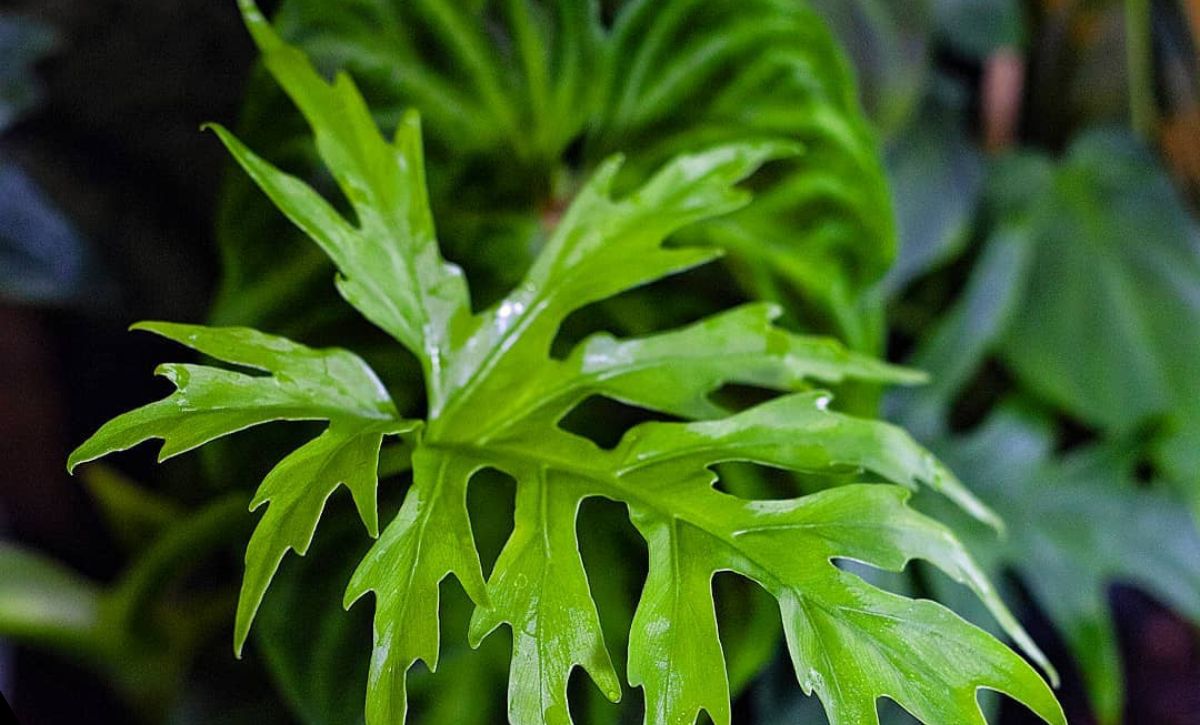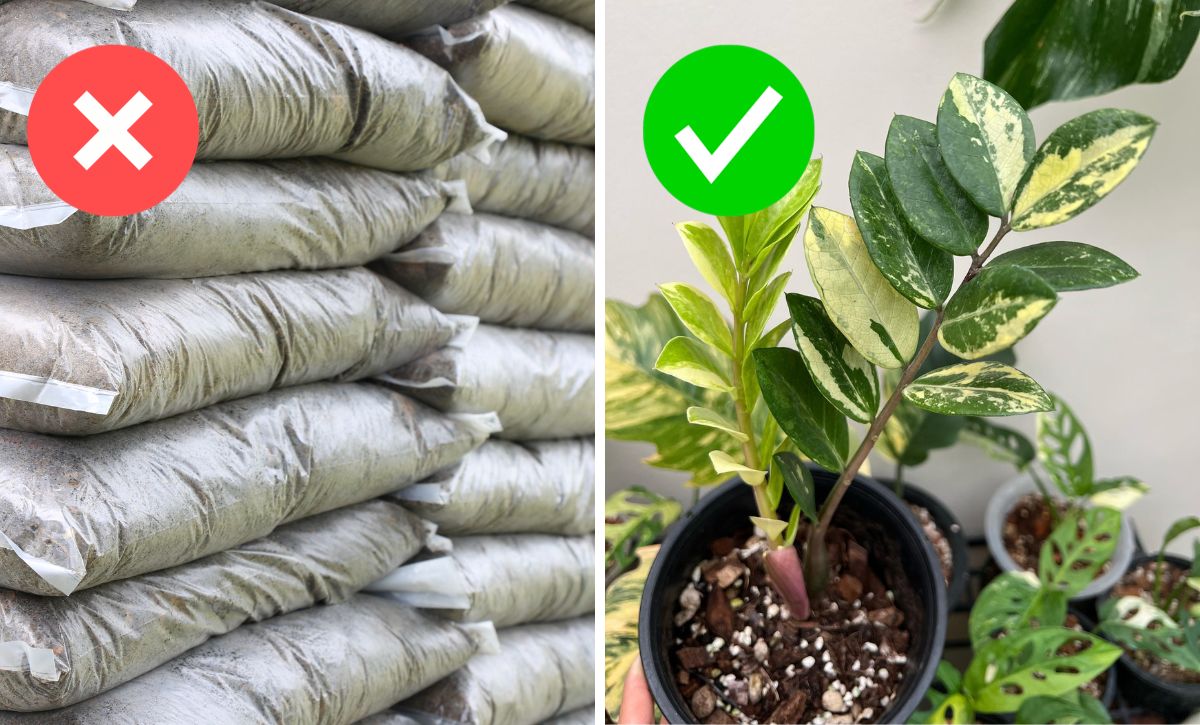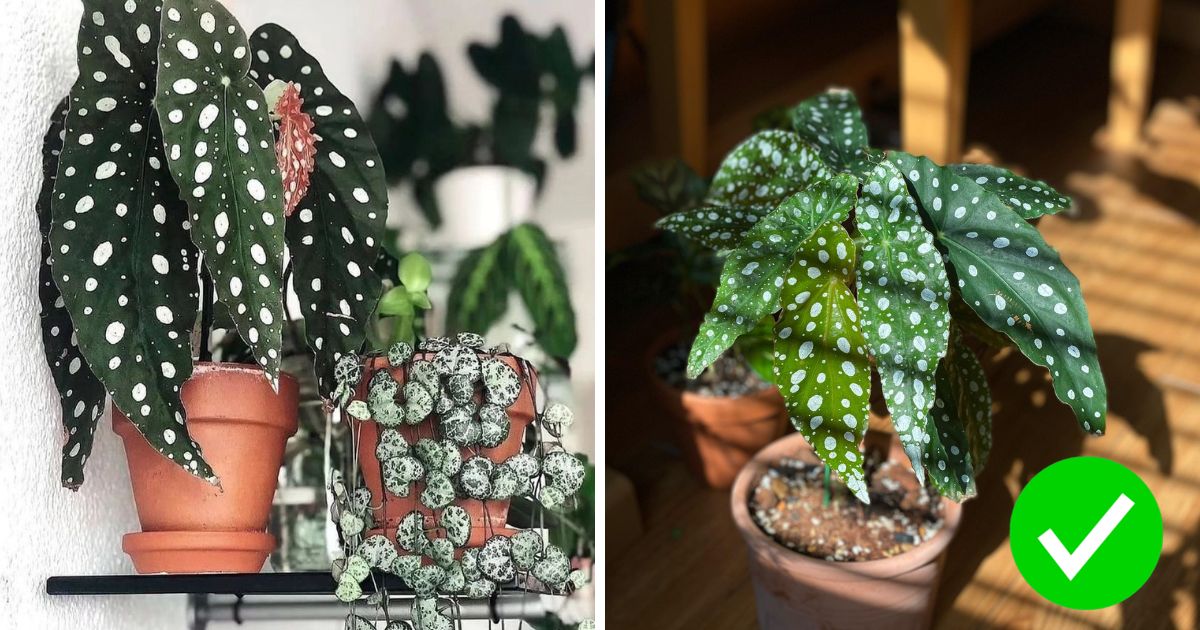If you’re a fan of house plants as décor, you have probably heard of Monstera plants. These plants are absolutely stunning for interior home décor since they are low maintenance, and their foliage is a sight to behold.
With so many monstera species and subspecies, it can be hard to tell which Monstera you’re rearing. Monstera Adansonii with dark green leaves that have fenestrations are the most common type of this plant.
However, due to the close similarities of these plants, it can be hard to tell if you’re growing a Monstera Laniata or Adansonii.
While monstera plants have similar plant care, understanding the requirements of what kind of plant you’re growing is important, especially when growing the variegated variety.
If you’re currently growing or looking forward to growing a Monstera plant, fret not! This article offers a detailed analysis to help you differentiate between Monstera Laniata vs. Adansonii.
The Key Differences in Monstera Laniata Vs. Adansonii
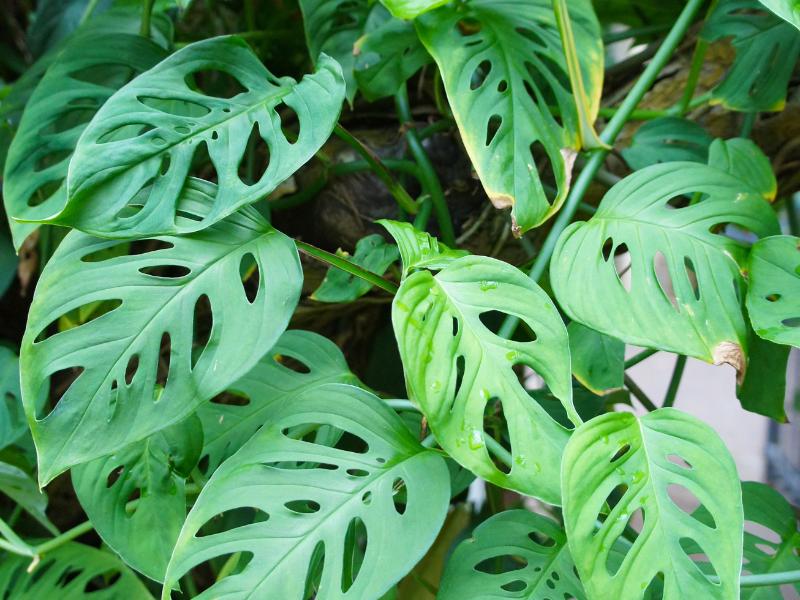
Differentiating between the two plants can be pretty tricky, especially considering that the Monstera Laniata is a subspecies of Adansonii known as Monstera Adansonii Laniata.
Despite the close similarities between the two, some clues can help you differentiate one from the other, such as fenestrations, size, and leaf color.
Size
The Monstera Laniata comes from the narrow Adansonii varieties. However, it tends to grow larger than other Adansonii plants. Monstera Friedrichsthalii is the go-to option if you’re looking to grow a small Monstera variety.
Leaves
Most Monstera plants are usually differentiated or divided based on their leaves, that is, whether the leaves grow to be round or narrow. Differentiation may also be in their variegation habits, in which case the variegated ones are way pricier!
In the case of the Monstera Laniata, it’s characterized by dark green leaves with a glossy appearance on the undersides. Since they are large in size, they also have larger leaves.
The Adansonii, on the other hand, have intense green leaves but a matte appearance on the undersides.
Fenestrations
Fenestration is one of the most unique features of Monsteras that distinguish them from other plants. The fenestration patterns can also be used to differentiate between different varieties of this plant.
The Monstera Laniata has symmetrical fenestrations, while the Monstera Adansonii has sporadic fenestrations.
The above key features will guide you in distinguishing Monstera Laniata from the rest of the Monstera subspecies. For me, looking for a matte or gloss appearance on the underside has always done the trick!
Plant Care Guide for Monstera Laniata vs Monstera Adansonii
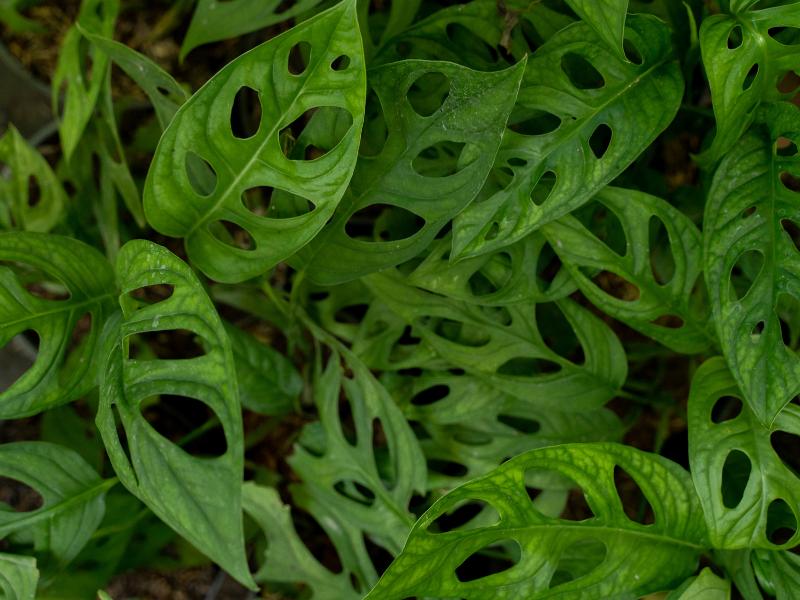
The Monstera plant originates from South America and belongs to the family Araceae. As we previously noted, both plants are basically the same and, as such, have a similar care guide.
Monstera Adansonii is also known as the Swiss cheese plant.
Here is a look at the plant care requirement for monsteras!
Water Requirements
Monsteras adore damp soil, so it’s best to water your plant until you see water coming out of the drainage holes. While these plants need to be watered regularly, you should wait for the soil to dry between waterings to prevent overwatering, which may lead to root rot.
Watering frequency will depend on certain environmental factors such as light, temperature, and humidity.
Plants that receive more sunlight and are in less humid areas will need to drain water quicker as compared to other plants.
Likewise, you’ll need to water the plants more frequently if you live in warmer temperatures or during the hot summer period.
Let the top 2-3 inches dry before watering to minimize the risk of overwatering. However, make sure that the soil does not completely dry out.
Soil Requirements
The best soil for Monsteras is slightly acidic, with a pH of 5.5 to 7.0. The soil should be well-drained and slightly moist for the plants to thrive.
Other than drainage, these plants will also thrive in soil rich in nutrient content such as nitrogen, which promotes the growth of new leaves.
To ensure that your monsteras thrive, you can create the perfect soil mixture by mixing one part peat moss + coco coir, one part sphagnum moss, and one part perlite + vermiculite. Alternatively, you can use fifty percent general-purpose potting soil, ten percent perlite, ten percent peat moss, and thirty percent orchid bark.
If you can obtain a soil mix made for aroid plants that contain peat moss and perlite, the better! The peat moss in the soil may reduce the pH, but it substitutes for this by increasing the nutrient content.
Light Requirements
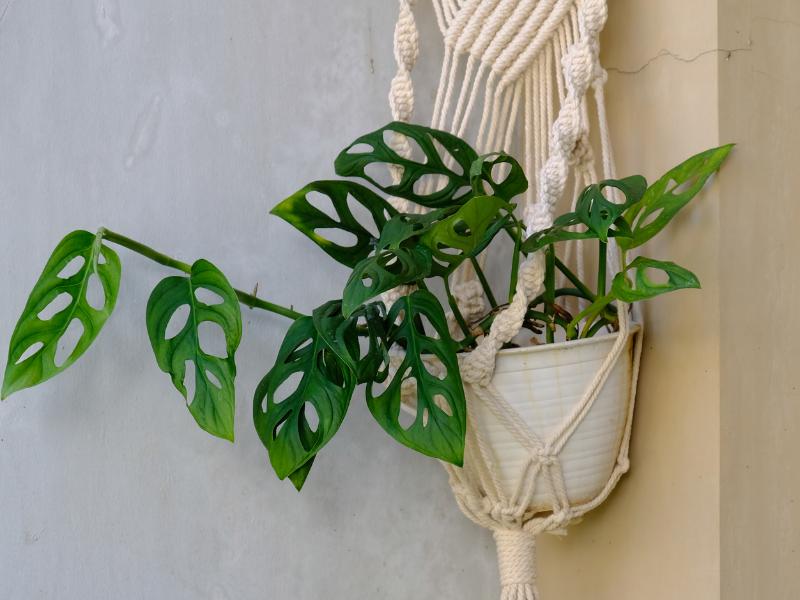
For your Monsteras plant to thrive, they will need to receive plenty of bright and indirect sunlight.
Monstera Laniata or Adansonii will thrive when receiving indirect sunlight and exposure to the direct morning or evening sunlight. Intense midday sunlight may lead to the plant getting scorched.
You can place your plants in a north-facing window to ensure it gets the proper light requirements. However, you’ll need to move the plant during winter since it won’t receive sufficient light there.
Another option is to grow the plant in hanging baskets to minimize the intensity of direct sunlight they get through the day.
In places where access to natural light may be difficult, you can illuminate the plant with grow lights.
Best Temperatures to Grow Monsteras
The optimal temperature to grow Monsteras plants is between 65℉ and 75℉. Luckily, this is easy to maintain in many homes.
The Adansonii will survive even when the temperatures get to lows of 55℉ and highs of 85℉. Ensure that the plant is well hydrated despite the temperature fluctuations.
Even though the Monstera Adansonii can survive low temperatures, it’s not frost resistant. Shelter your plant inside when temperatures drop below 50℉.
Monstera plants don’t do well near cold drafts, so ensure that you keep the plants away from air conditioners and vents. Additionally, keep the plants away from radiators or fireplaces since sudden temperature changes could be harmful.
Humidity Requirements
This is relatively easy! Anything above 50% should suffice since these plants prefer high humidity levels. If humidity levels fall below this percentage, your plant could develop health problems.
To prevent this from happening, you’ll need to increase humidity artificially. Fortunately, there are several easy strategies to increase humidity.
For one, you can purchase a humidifier to control humidity levels around the plant or use a pebble tray.
Another effective, low-cost solution is misting your plants regularly or placing them in high-humidity areas such as the kitchen or the bathroom.
Fertilization Requirements
Monsteras will do well when fertilized once a month during the growing season.
Fertilization should be done with an all-purpose liquid fertilizer. However, ensure that it’s diluted to half strength first.
This fertilizer regimen shouldn’t be applied after repotting your Swiss cheese plant.
After repotting, fertilizer should be applied to the new soil after 6 months since the soil usually has fertilizer already.
Ensure that you adhere to the manufacturer’s guidelines when using fertilizers. Deferring from the guidelines could lead to unwanted outcomes.
Repotting
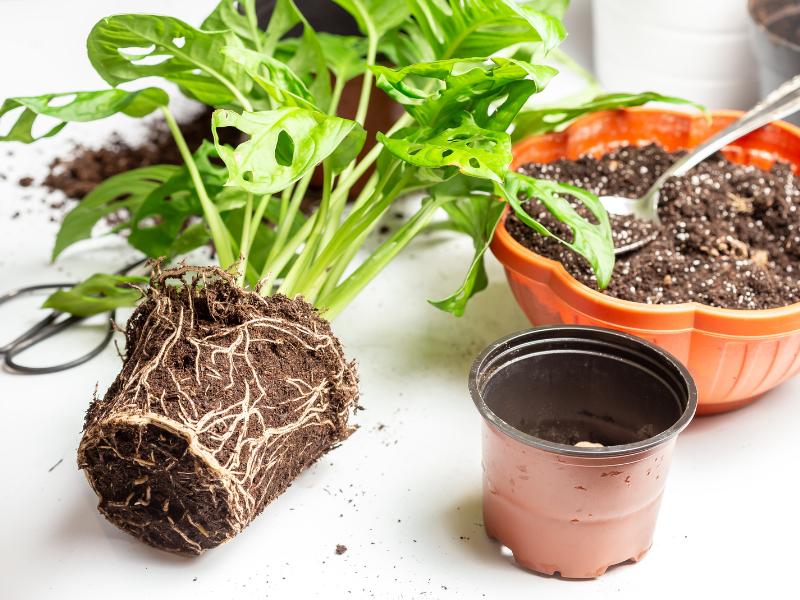
Repotting should be done after every two years. The best time for repotting is at the beginning of the growing season to give Monstera ample time to familiarize itself with the new environment.
There are several things you need before repotting your plant: new potting soil, fresh pot, sterile pruners, and some water.
Take into account the size of the plant when choosing a pot; a small pot will hinder the growth of the roots, while a way too large pot will delay growth since the young roots can’t tolerate too much soil around.
The potting material is also essential since different materials have different water retention rates.
When filling the new potting mixture, ensure it’s loose and well-drained.
Removing the plant from the old pot should be done slowly to ensure the roots aren’t harmed. Tilt the pot to one side to slide the plant out.
Next, remove as much soil as you can from the roots. Do this gently to ensure you don’t cut the roots. This is also a great time to inspect the roots for infection! Use sanitized pruners to remove any infected roots.
In a pot filled to one third with fresh soil, place the Monstera in the center.. Add some extra soil to the pot, water the plant, and voila! A repotted Monstera.
Pruning
This is not a crucial care guide step for Monstera plants. However, it is advisable to remove any discolored leaves.
To control the shape of your Adansonii, cut away a few branches during the growing season to your desired shape.
Propagation
Did you know that the Monstera plant was once a rarity? That’s right! This plant was once hard to find, but thanks to its easy propagation, it’s now easy to find, and you can have as many monsteras as you want (if you propagate them right).
There are different ways to propagate this plant, including stem cuttings, water propagation, and soil propagation.
Here are the different ways to propagate the Monstera Laniata and other Adansonii subspecies.
Stem Cuttings
The tricky part about propagation with stem cuttings is understanding how to make the stem cuttings.
Here are some tips on how to make good stem cuttings.
First, always use sterilized equipment to make cuttings.
To increase the chances of success, make cuttings with at least one node.
Cuttings can either be directly planted in the ground or submerged in water before planting.
Propagation by Water
To propagate your monstera plant by water, follow the following tips:
- Fill a jar or container with water.
- Dip the cutting in a rooting hormone to speed up the root formation.
- Now take the cutting and submerge the bottom in the water while ensuring the leaves don’t come into contact with the water.
- Ensure that the jar is placed at a place where it can receive indirect sunlight.
- Change the water every three days until growth is noted.
As soon as you note growth, you can plant the cutting in soil. Growth will be exhibited by the formation of little roots.
Soil propagation
Propagation by soil may help your plants develop a better rooting system. It is, however, essential to ensure that the soil you’re propagating in is porous and has good drainage.
Follow these steps to propagate:
- In a container or pot, place some soil
- Take the cuttings you have made and keep them in a rooting hormone to accelerate the speed of root formation.
- Dig a hole in the container and place the cutting in it. Ensure that one of the nodes is below the soil surface.
- Cover the cuttings bottom part with a plastic bag with holes to allow airflow.
- Place the container in a place where it can receive indirect light.
- Always ensure that the soil is moist by watering or misting it.
Common Issues
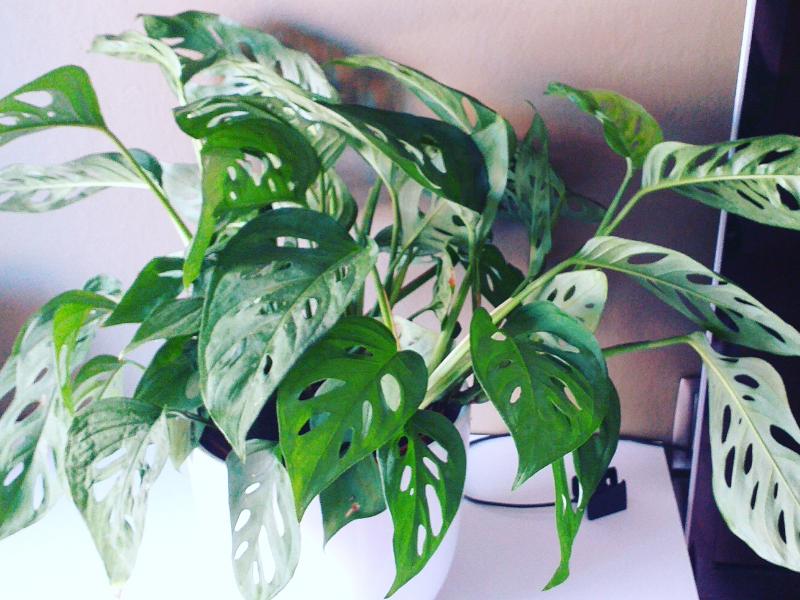
Despite the mesmerizing beauty of these plants, they also have some bad issues. However, with the proper care and attention, these plants should grow fairly unproblematic.
The best way to take care of your plants is to meet their needs in the right way. After all, prevention is better than cure.
However, in the unfortunate event that you run into some issues, this section will discuss how you can effectively deal with them.
Pests and Diseases
The most common pests for Monstera Adansonii are scales and spider mites.
Pests like spider mites can be removed by a cotton swab dipped in alcohol. However, this method is only effective when the number is small.
For infestation by scale pests, then neem oil is the best solution. The entire leaf surfaces of infected leaves should be sprayed by neem oil in a fine mist.
It’s a no-brainer for any gardener that indoor plants like Monsteras are susceptible to diseases like leaf spot.
Using a copper-based fungicide is an effective way to treat this condition.
Leaves Discoloration
Leaf browning and yellowing in Monsteras is mainly caused by overwatering. Another primary cause is exposure to direct sunlight.
You can correct the leaf discolouration such as browning or yellowing by adjusting the watering levels of the plant. This minimizes the risk of root rot.
Common Monstera Varieties
For Monstera enthusiasts who would like to expand their Monstera collection, you can try different varieties of Monstera.
Some of these are Adansonii, while others are not even Monsteras!
Here is a list you can explore.
Monstera Obliqua
One of the rarest Monsteras in the world. The leaves of the obliqua have so many holes that it resembles a plant skeleton. The leaves are stringy and thin, so the plant appears to be wilting even when it’s healthy.
Due to the numerous holes in the foliage, the obliqua receives less chlorophyll and, as such, remains small for the entirety of its life.
The rarity of this plant makes it extremely pricey. With only 17 species available around the world, you’ll be incredibly lucky if you can get your hands on this Monstera.
However, due to the rarity of the species, they have been crossed with other species. So, there’s still hope!
Monstera Deliciosa
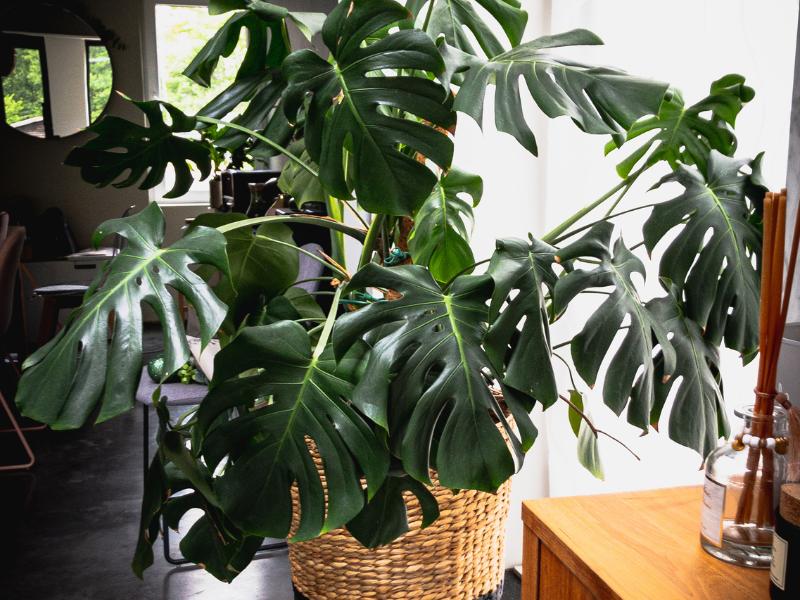
Like many Monsteras, the leaves of this plant also have a unique shape where they appear to have been precisely chopped with scissors. The fleshy upward spadix gives the plant a lovely appearance.
Another popular feature of this Monstera is its edible fruits. That’s right! The plant develops spathes which turn into delicious fruit.
The size and quantity of the leaves will vary depending on the plant’s growing conditions.
Did you know that the holes in the monstera plant are a result of the plant’s evolution to withstand strong winds and offer weight relief? I know! Such a cool fact, right?
Growing this plant provides double benefits, fantastic décor, and delicious fruits!
Monstera Lechleriana
This monstera variety resembles the famed Adansonii. However, it differs in the sense that it has rapid growth and occupies more space.
The plant produces tight clusters of 10-15 leaves. Due to extensive foliage, the plant overlaps on the petiole bases hiding the stem, and the internodes are shorter.
Monstera Lechleriana has fewer holes which are smaller in size compared to other varieties. These fenestrations may not even exist in smaller plants but will likely appear as the plant matures.
Mini Monstera
The mini Monstera is associated with two main species; the Rhaphidophora Tetrasperma and the Split-leaf Philodendron. While they’re two completely different species, they remarkably resemble each other.
But here’s the catch! They aren’t even monstera species at all! The only similarity they have with Monsteras is that they are from the Araceae family.
The reason that this plant is included in the list is that it resembles the common Monstera perfectly, albeit a bit smaller.
While the fenestrations may extend to the margins of the leaves, the mini Monstera has a more notched appearance and develops dark green foliage.
Monstera Acuminata
Although not as popular as other Monstera varieties, the Acuminata is worth mentioning since it’s a hemiepiphyte; it grows horizontally on the ground in its early stages as it searches for a place to climb.
Ooh yeah! We’ve got a climber here, and it will need some kind of support once it starts climbing.
In its natural habitat, the plant will grow as tall as 98 feet but don’t start making space in your house just yet. As a houseplant, the Acuminata will grow to about 8 feet tall.
As the plant matures, it will develop fenestrations and lovely dark-green foliage.
Monstera Epipremnoides
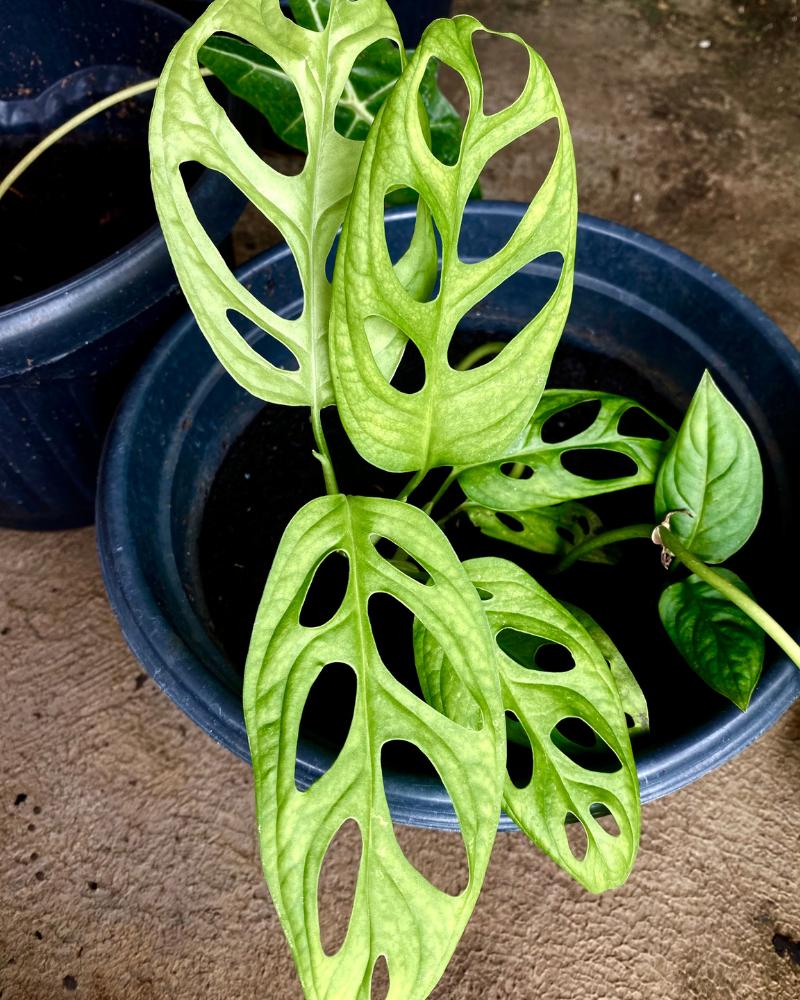
This is one of the common monsteras in the market, also known as monstera Esqueleto. The plant leaves have a familiar fenestration pattern that is thin and pointed.
While most of the monstera varieties have a dark-green color, the Epipremnoides has a light green color that makes it not only unique but also absolutely stunning!
Monstera Peru
Unquestionably one of the most unique Monsteras you can grow, and the reason is it lacks fenestrations which are a typical hallmark of all Monstera plants.
Its leaves are characterized by a dark green color and have pronounced veins that get darker as the plant ages.
This tiny compact plant thrives in diffused light. While support is not absolutely necessary for the plant, it won’t hurt to provide some to the plant as it grows taller.
Common Questions Asked
1. What are the different types of Monstera Adansonii?
Monstera Adansonii are differentiated based on their appearance. This is based on whether they have a narrow or round form and the different types of variegation.
Another crucial part of differentiation is whether they are variegated or not.
Here are the five main subspecies of Monstera Adansonii:
- Monstera Adansonii Laniata
- Monstera Adansonii Friedrichsthalii
- Monstera Adansonii Blanchetii
- Monstera Adansonii Archipelago
- Monstera Adansonii Klotzschiana
2. What are the differences between the Laniata and Adansonii monstera species?
For one, the Laniata is a subspecies of Adansonii. Its full name is the Monstera Adansonii var. Laniata. Even with close similarities, the devil is in the details, with minor notable differences between the two.
The Monstera Adansonii is smaller than the Laniata, and its leaves have a matte finish, unlike the Laniata, which has a glossy finish.
Another difference is that the Laniata has symmetrical fenestrations, while the Adansonii has sporadic fenestrations.
3. What is the care guide for Monstera Laniata?
Like many other Monstera plants, your Laniata should be placed in a place where it receives bright indirect light. Ensure the plant is grown in well-drained, loose soil rich in nutrients.
Keep the plants in a place with 50% humidity and a temperature of 65- to 75℉.
Most importantly, ensure you water your plant and repot it once it has outgrown its current pot. Watering should be done when the soil’s top 2-3 inches dry out.
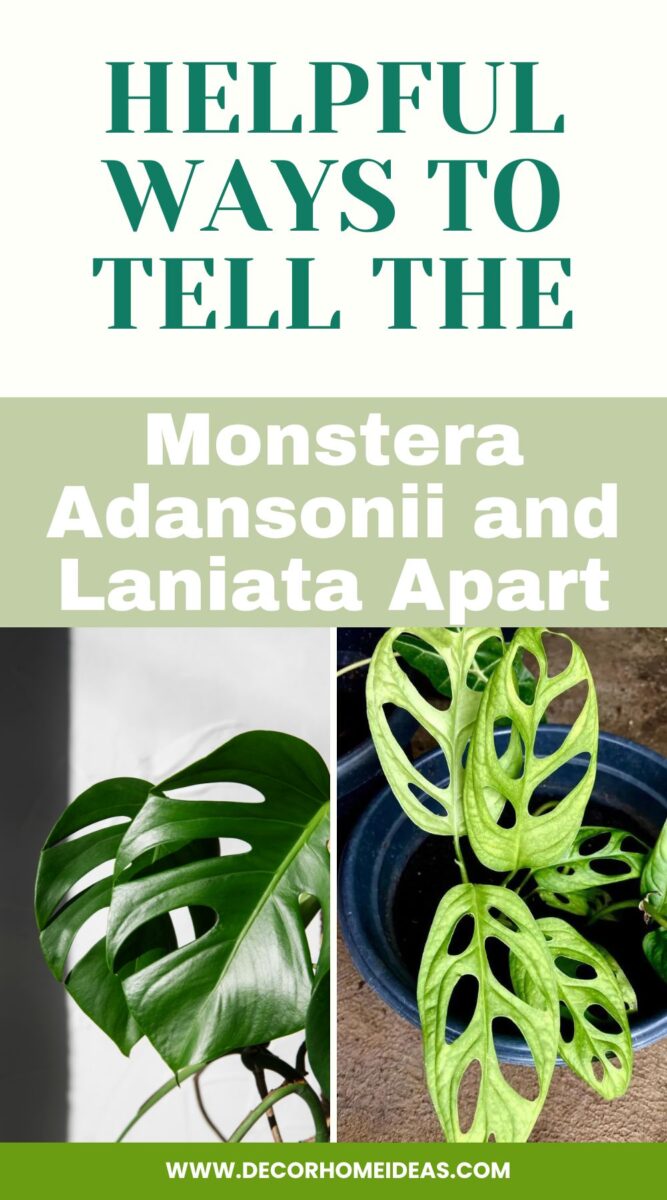
Bottom Line
Even though the two plants are closely similar, it’s clear that they have some differences. Take a closer look at the plants’ underside to discern the differences.
The thorough analysis done on this article shows just how easy it is to deal with Monstera Laniata and Adansonii.
Always ensure the plants are healthy by watering and keeping the right temperature and humidity. And remember, when in doubt, matte is for Adansonii, and glossy is for Laniata!
That’s all for now. Have a wonderful day!

